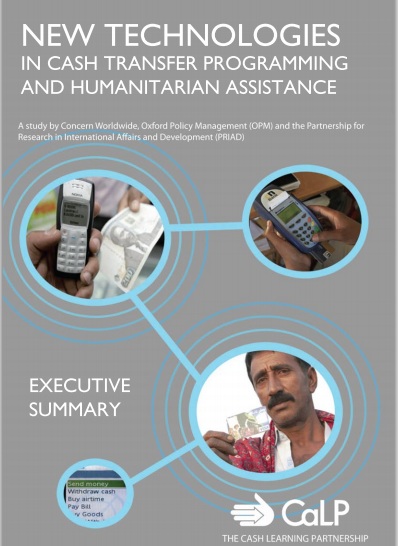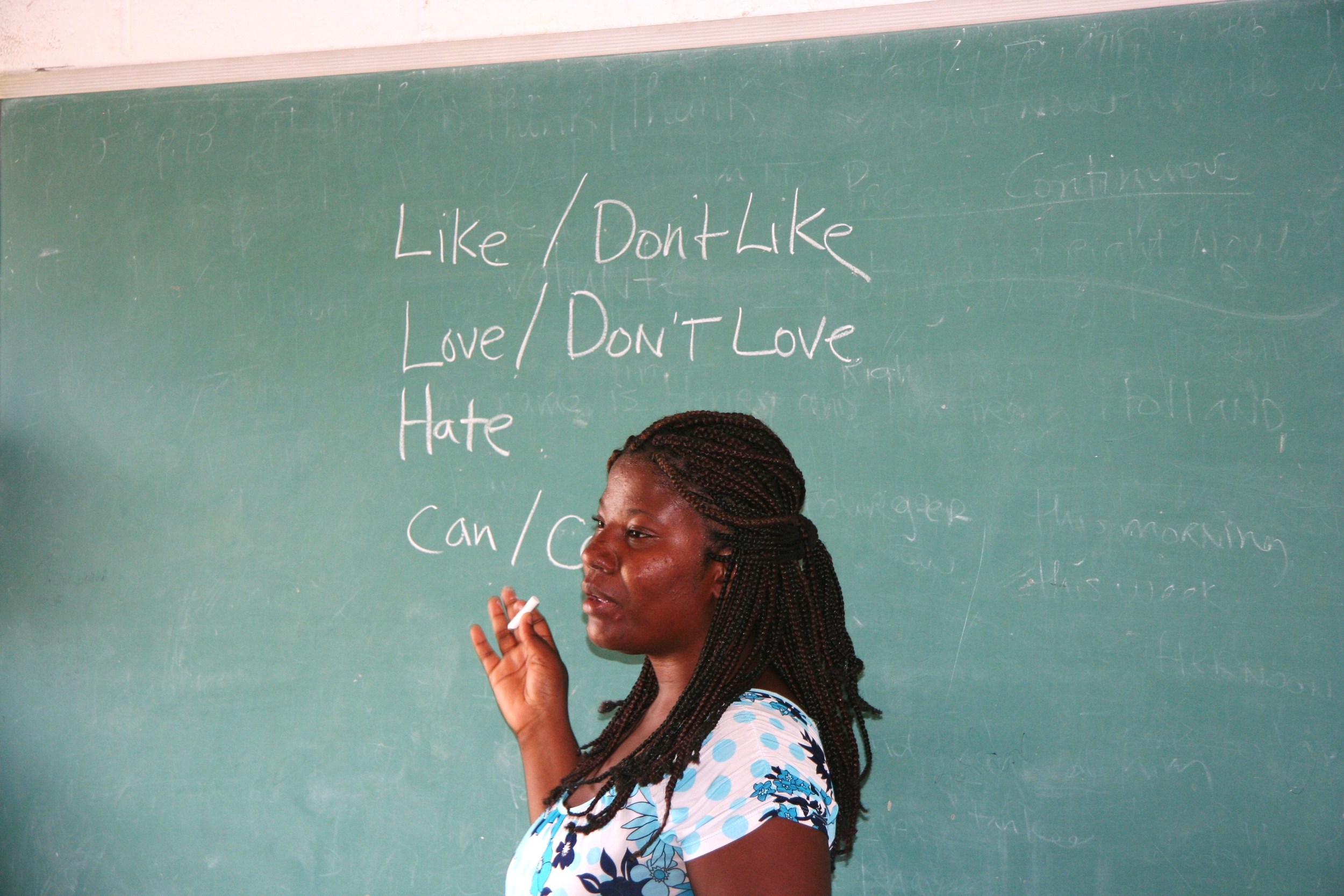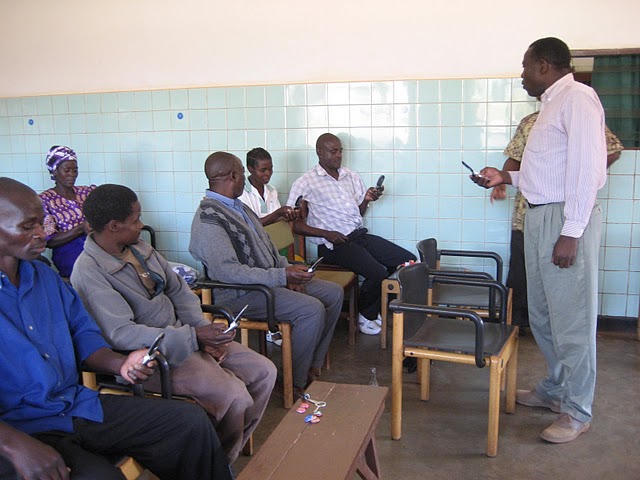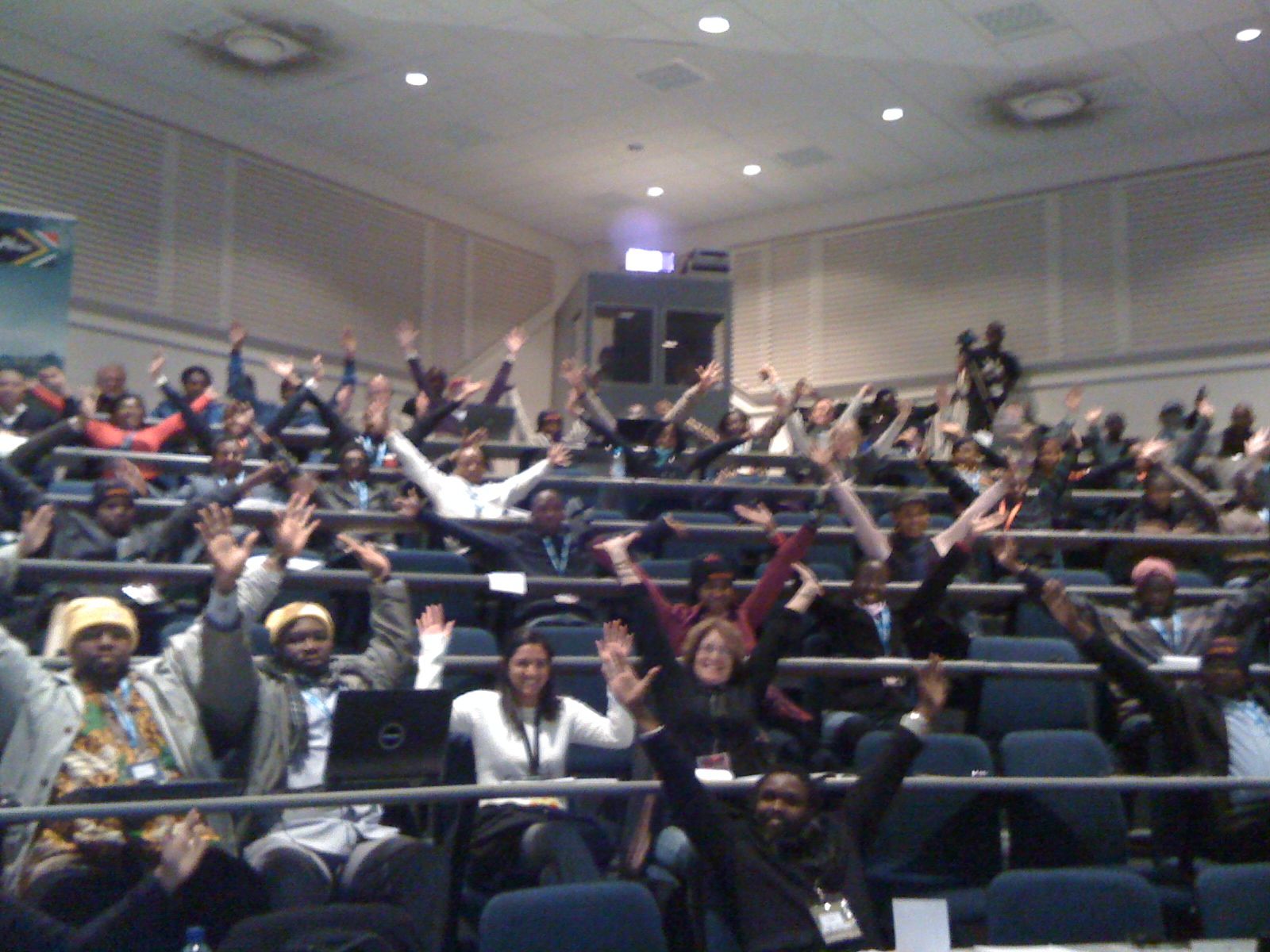In the seventh and final post in our FrontlineSMSat7 series, our CEO Laura Walker Hudson highlights a FrontlineSMS use case that makes her happy - ActionAid's award-winning, bi-continental pilots of FrontlineSMS in Africa and Europe.
Technology Meets Humanitarian Response
Over the last two years, we have worked to raise awareness of the potential of SMS, and FrontlineSMS, as a sustainable, capacity-building tool in humanitarian response. We have documented how our software is being used to manage and coordinate aid responses by a wide variety of organizations - including OCHA, Action Aid and Infoasaid, European Disaster Volunteers, Popular Engagement Policy Lab – and in a range of contexts - including Kenya, Pakistan and Haiti. We have also produced a tailored checklist on what to consider when planning use of mobile technology for humanitarian response. All of this content is representative of a more general trend; that of a growing number of humanitarian organizations keen to engage with how ICTs can help support their work.

In March 2012, we participated in two events in London which demonstrated this increasing interest. The first, a two-day Media and Tech Fair hosted by the Communicating with Disaster Affected Communities Network (CDAC), showcased technologists and implementers from all over the world, sharing with an audience of CEOs and decision-makers how their solutions and pilots have begun to change the way they engage and communicate with the people they work to help. The second day of this event featured practical workshops and scenario-based discussions, intended to help people to think through how they could put these tools and approaches into practice on the ground.
The second was an afternoon event - co-hosted by the Overseas Development Institute (ODI), Active Learning Network for Accountability and Performance in Humanitarian Action (ALNAP) and the Cash and Learning Partnership (CaLP) - launched an excellent report written by the team at Concern UK: New Technologies in Cash Transfer Programming and Humanitarian Assistance. Our Director of Operations, Laura Walker Hudson, participated in a panel discussion reflecting on the themes raised in the report, and we were pleased to have had the opportunity to have contributed to Concern’s research.
The report takes an in-depth look at the current use of new technology in humanitarian cash and voucher programming, and the broader implications this has for humanitarian practice. In addition to some positive cross-cutting themes – such as the improved accountability and cost-effectiveness which can result from successful use of technology in humanitarian work – the report also contains advice on mitigating some of the challenges that still obstruct wider implementation. The result is a thoughtful and broad-based survey of the opportunities and challenges facing humanitarian agencies in selecting and rolling out technological tools - reflections which are valuable across all sectors, not just humanitarian aid, for their honesty in assessing institutional barriers to change and innovation. We will examine some of these issues in a future post, and consider their relevance for anyone trying to mobilize information management and communications.
For now, a few broad themes recurred in both events:
- Disaster affected populations are already utilizing ICTs on the ground, and the globalized nature of news and volunteerism means that groups like the Standby Taskforce are pitching in to help manage and process data. If agencies fail to acknowledge progress made by others, they will be left behind.
- Erik Hersman, one of the founders of Ushahidi, reiterated a core value we share in his keynote summary of the first day of the CDAC event: technology is only a small part of what needs to be considered in planning discussions; the context, the program design, training and sustainability, and most importantly, listening to the people the project seeks to help, are a larger part of the effort and critical to success.
- The critical importance of cross-sectoral and inter-agency collaboration recurred again and again, at both events. To avoid duplication of effort, conflicting data standards, wasted resources and crowded information marketplaces in emergencies, key stakeholders must work together, and seek to understand others’ perspectives in a rapidly evolving area. Working in a consortium, or creating open-source tools available to everyone, could potentially speed up development of useful platforms and improved learning about what works and what doesn’t. Collaborating effectively with the private sector and with technologists could far more effectively harness additional resources and intellectual capital, and a coordinated ask of major players, such as the GSMA, is crucial - but can feel impossible to secure.
All in all, the humanitarian sector has a long way to go, particularly at head office level, but our team was left with a sense that there are a growing number of humanitarians who are taking an agile, open and open-minded approach to trialling new tools and sharing their findings with others. Yet it is at field and regional level that the real innovation is happening, away from the overlapping priorities and initiative overload that characterizes the global management hubs in New York, London and Geneva. As ICTs in humanitarian aid become more commonplace and begin to integrate more fully into the standard agency toolkit, agencies, technologists and the private sector must continue to build relationships and exchange information in order to build sustainable, coordinated, and appropriate use of technology in humanitarian response.
Following both of these events, valuable resources have been made available online:
CDAC event:
- All videos, photos, case studies and resources from the day can now be found online
- Case studies featuring FrontlineSMS use include:
- Using FrontlineSMS for a complaints and response mechanism after the Pakistan floods
- Infoasaid and Action Aid partnership and communications initiative in Kenya
- International Organization for Migration - Flood Affected Citizens Damage Compensation Program (whose use of FrontlineSMS we covered on our blog here)
ODI and CaLP event:
- New Technologies and Cash Transfer Programming in Humanitarian Assitance Report
- Videos from the panel discussion at this event, including our very own Laura Walker Hudson
Supporting disaster affected communities in Haiti using FrontlineSMS
Guest post from Andy Chaggar, Executive Director of European Disaster Volunteers (EDV) who are using FrontlineSMS in Haiti:
European Disaster Volunteers' mission is to help disaster affected communities worldwide achieve sustainable recovery. This means doing more than simply addressing the damage caused by disasters; it also means addressing the underlying, long-term factors that made communities vulnerable in the first place.
We’ve been working in Port-au-Prince, Haiti since June 2010 and have placed a high priority on education since the beginning. EDV has rebuilt or repaired 36 classrooms in eight schools, are providing scholarships to 50 primary school children, and also run free English classes for adults.
Having originally graduated with a degree in electronic engineering in 1999, this work is a major change in direction for me. However, given my previous career it’s probably not surprising that I’ve retained a strong interest in technology, particularly in its application to disasters and development. So, when I heard about FrontlineSMS, I immediately saw its usefulness to EDV’s current work in Haiti.
From the outset I knew FrontlineSMS would be particularly helpful for our English Education program. English is a key vocational skill for Haitians seeking employment and, almost as soon as we arrived, we started getting requests from our community for language support. Over the past 17 months, what began as informal classes has developed into a structured program that includes 120 students in eight weekly classes at four different levels.
Managing communications in the program was a challenge from the outset. In addition to the students, we have to coordinate our Haitian teachers and international volunteers. Everyone needs to be kept informed of the time and location of meetings and scheduled classes are prone to disruption.
In a country like Haiti, everyday issues like teachers being ill are compounded by problems of instability. Potential hurricanes, political unrest or simply a particularly heavy rainstorm all have the ability to disrupt class, so the ability to communicate is vital.
Very few Haitians have regular access to the Internet so group emails aren’t an option. Before using FrontlineSMS, we would often have to scramble to call, or text, everyone affected to reschedule a class. In some cases, such as during heavy rain, an unlucky volunteer would have to walk to a class where we knew very few students would turn up simply to apologise to the few who did and tell them to try again next time.
Now, by using the software’s ability to create contact groups, we can very quickly and cheaply text all students in a given class or call all of our Haitian teachers in for a meeting.
Our English program is very popular and also has a big waiting list. When spots in our various classes recently opened up, we were also able to use FrontlineSMS to text over 100 prospective students and invite them to take a placement test so we could fill the classes with students at the right level.
Overall, this simple but effective technology has made managing our English Program much easier. Without FrontlineSMS, we would still be using chaotic, time-consuming and inefficient methods of communicating, all of which would distract and disrupt the actual work of teaching.
The fact that FrontlineSMS is free is also very appealing to us. While we’re a growing charity, we’re still fairly small and love to save money by using free technology. Beyond this, however, an important principle is at stake. EDV is committed to working with disaster survivors to build local capacity to meet local needs. This partly means connecting survivors with tools they can use themselves. Even if we could afford to buy expensive, licensed software, the survivors we work with never could. As a result, we always prefer to use technology that is as accessible to survivors as it is to us.
We’re in the process of handing over leadership of the English Program to our local teachers and a Haitian school administrator. As part of this process, we’ll be providing a computer with the software and contact groups installed so that our communications solution is transferred. We’ve found using FrontlineSMS to be very intuitive so we’re confident our school administrator will continue to retain and develop use of the technology.
We have other future plans for use of FrontlineSMS in addition to our English Program, and see many ways it can help us operate more effectively. We currently also use the technology for our own internal messaging which is critical in Haiti due to security issues. Political demonstrations can be dangerous and can happen with little warning, so being able to quickly text all of our in-country volunteers and tell them to return to base immediately helps keep everyone safe.
We’ll definitely continue to use FrontlineSMS internally in other disaster zones, and we will continue to explore other potential project-related applications for the technology as well. For example, a couple of years ago I visited a community group in the Philippines who provided early warning alerts to its members living in typhoon and flood prone areas of Manila. While doing an amazing job, they were reliant on an aging infrastructure of radios and loudspeakers and this process could have been strengthened using FrontlineSMS.
I see the need for such early warning systems time and time again and I’m fairly confident that in the future such work could be complemented and improved by using FrontlineSMS to quickly text those in danger. Moving forward, I’m excited to see how FrontlineSMS, and technology overall, can be applied to solve important real-world challenges and both help to save and improve lives.
UN uses FrontlineSMS to help manage aid response in East Africa
em>By Lisa LaRochelle, FrontlineSMS Project Assistant FrontlineSMS is being used for social change in many different ways across the world. Common use case examples include election monitoring, provision of health information, and agricultural support – these kinds of use cases have direct positive impact on people’s lives. Yet here at FrontlineSMS we have seen increasing numbers using FrontlineSMS for organisational management, which has indirect benefits for people which are
far harder to measure and demonstrate; helping organisations to work more efficiently, communicate more easily with their staff, and move information around more swiftly. Examples include using FrontlineSMS for monitoring and evaluation, data collection, and internal communication. It is this latter kind of FrontlineSMS use case that we recently discussed with Sanjay Rane, Information Management Officer at the United Nations Office for Coordination of Humanitarian Affairs (OCHA) in Kenya.
Mobile phone penetration is high in Kenya, and the UN OCHA staff members that Sanjay works with all have their own mobile phones. The convenience and accessibility of SMS appealed to the team, and FrontlineSMS is a low-overhead way of managing text messages to and from groups. “For the last couple of months we have been using FrontlineSMS as an in-house communication tool,” Sanjay explains “and it has certainly helped foster better information sharing among the OCHA Kenya team.”
SMS offers an immediacy and intimacy that can be seen as unique from other methods of communication. People always have their mobiles close to them, and generally read messages quickly. This has certainly shown to be the case in OCHA’s experience. They have found that using SMS helped them to reach staff, especially during an emergency occurring in off hours, when most of the staff do not check their emails. OCHA Kenya can use the tool to send out urgent updates to the team.
One of the major benefits of using FrontlineSMS is the ability to manage SMS more easily than using a simple phone handset. When trying to send out messages using a handset, Sanjay found it difficult and time consuming to add and delete people’s contact information, send messages to multiple contacts at the same time, and maintain groups of contacts. FrontlineSMS offers a simpler solution: the ability to sort contacts into groups so that, for example, an emergency alert text can be sent out to a large group of staff at once. It is also possible to set up key words and automatic replies with FrontlineSMS, so the system can automatically send people important advice and information.
The OCHA Kenya team had such success with their experience that they decided to implement FrontlineSMS to facilitate communication with a larger group of humanitarian partners in Kenya, as a preparedness tool for the referendum in 2010. They are now exploring the possibility of using SMS to help coordinate with agencies responding to the current East Africa drought. This is an indication that FrontlineSMS is enabling improved communications management in a way that was otherwise not possible.
It was the capacity to manage data in combination with the popularity and simplicity of SMS which led Sanjay to FrontlineSMS. “At OCHA Kenya, using SMS for internal communication is very popular, as it is a familiar communications tool. We have found it really valuable to use SMS for communicating with colleagues on important humanitarian developments in Kenya,” Rane says. Organisational management, although behind the scenes, can provide huge social benefits by enabling those working for NGOs and INGOs to communicate more effectively and do their challenging jobs more efficiently
Combating food insecurity in Northern Kenya
a href="http://infoasaid.org/" target="_blank">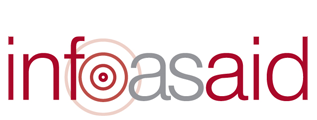 infoasaid is a consortium of Internews and the BBC World Service Trust. The objective is to improve how aid agencies communicate with disaster-affected communities - the focus is on providing humanitarian information. The emphasis is on the need to deliver information, as aid itself, through the most appropriate channels. In this guest blog post first published on their website, infoasaid highlight some of the innovating approaches they are piloting to using FrontlineSMS in communicating with communities affected by crisis.
** This use of FrontlineSMS has also been reported on by ActionAid, the BBC World Service Trust and ReliefWeb. In addition, we included it in our National Geographic blog series, Mobile Message. **
infoasaid is a consortium of Internews and the BBC World Service Trust. The objective is to improve how aid agencies communicate with disaster-affected communities - the focus is on providing humanitarian information. The emphasis is on the need to deliver information, as aid itself, through the most appropriate channels. In this guest blog post first published on their website, infoasaid highlight some of the innovating approaches they are piloting to using FrontlineSMS in communicating with communities affected by crisis.
** This use of FrontlineSMS has also been reported on by ActionAid, the BBC World Service Trust and ReliefWeb. In addition, we included it in our National Geographic blog series, Mobile Message. **
Targeted, reliable information can help save lives in crisis-affected communities. As famine is declared in neighbouring Somalia, we’re helping ActionAid to improve vital communication with drought-affected populations in northern Kenya.
Open source mobile solutions such as FrontlineSMS and Freedom Fone are enabling two-way communication with vulnerable communities.
A chronic problem
Isiolo County in north eastern Kenya suffers from chronic drought and food shortages. A population of about 143,000 mostly semi-nomadic pastoralists rely on their herds of camels, cattle, goats and sheep for daily food and much of their cash income.
Many of the communities in this semi-arid area have been continuously dependent on food aid from the World Food Program (WFP) since 2004. ActionAid has been heavily involved in both long term development and drought-response projects in the Isiolo area for more than 15 years.
It knows that better communication can help save lives.
Livestock information bulletin
 The BBC WST and partners Internews are collaborating through the “infoasaid” project to help ActionAid provide timely information to pastoralists, to help combat food insecurity.
The BBC WST and partners Internews are collaborating through the “infoasaid” project to help ActionAid provide timely information to pastoralists, to help combat food insecurity.
Weekly information about livestock and food commodity prices in Isiolo market – the main reference market for the region – is sent through SMS messages (using FrontlineSMS software) to field workers in rural communities, who post the information on local noticeboards.
Given high illiteracy rates in the area, the project is also providing a recorded message service using Freedom Fone that allows people to listen to local Swahili updates.
The bulletins help drought-distressed pastoralists to keep tabs on the price of staple foods such as maize, beans and vegetable oil on which they increasingly depend.The bulletins help drought-distressed pastoralists to keep tabs on the price of staple foods such as maize, beans and vegetable oil on which they increasingly depend. The market information also allows them to achieve better prices for the animals they sell to traders – boosting cash household income.
Local news and information given alongside market prices also contain useful tips on issues affecting the well-being of animals. Items will include updates on rainfall, outbreaks of animal disease and de-stocking programmes.
Together, the two channels allow pastoralists living in isolated communities to access reliable and up to date market information. They also allow ActionAid to keep in closer touch with the village relief committees that handle food distribution to individual families.
250 basic mobile phones and solar chargers purchased as part of the project are also being used by village relief committee members who live in or near locations with network coverage.
The cheap and durable solar chargers are vital in areas without electricity. They can also provide a source of revenue (as they charge other mobile phones for a modest fee) that allow relief committees to purchase vital air time for their phones.
Faster data
An additional aim of the Isiolo project is to speed up ActionAid’s collection of data from the field.An additional aim of the Isiolo project is to speed up ActionAid’s collection of data from the field.
FrontlineSMS allows ActionAid to transmit electronic forms to field staff in Isiolo County via mobile phone. These are filled in electronically and dispatched immediately to the regional office through SMS messages.
These FrontlineForms are now being used to transmit time-sensitive reports on issues such as food distribution, food for work activity, malnutrition rates and local food prices. The information arrives rapidly in a standard format which is easy to analyse.
In the long term, this will help ActionAid to ensure its humanitarian aid activities in Isiolo are more effective and more responsive to the needs of the local population.
Communication as aid
In any emergency, be it natural disaster or man-made, long- or short-term, people's lives are turned upside down. Knowing what's happening, where to go for assistance and who to call for help is crucial to their survival and recovery.
The goal of the 'infoasaid' project is to help humanitarian organisations integrate two way communications with affected communities into their emergency programmes. This in turn improves the effectiveness of aid delivery.
As the drought and famine crisis in the Horn of Africa deepens, such communication is more important than ever.
A new 'Communication is Aid' animation, produced by infoasaid, demonstrates the positive impact of two way communication with crisis affected populations.
Read more about the work of infoasaid on their website.
What could an SMS do in humanitarian aid? Monitor a programme, send in a complaint... and administer a cash transfer?
Lawrence Haddad's recent column in the Guardian (23rd June) got me thinking about ways to use mobile to enable communities to hold agencies, whether governmental or not, to account for the aid they provide. This is a critical element of good development and aid work. As Haddad says;
Helping communities report on whether the aid reached them is a good contribution to fixing the broken feedback loop in international development and to reducing waste and corruption. But asking these communities if the aid was working – and how they define "success" – would be even better.
I can easily imagine using FrontlineSMS to administer a complaints and response mechanism using SMS; the agency could publicise a number, and complaints could come in from community members by text, even from a village phone provided as a livelihoods element of the programme. The agency could auto-reply to the message with thanks; and where appropriate, respond or request more information by text as well. The list of numbers they collect would enable them to send out text updates on their progress, and perhaps announce meetings and focus group discussions.
Enter PatientView - and complex data management using SMS
But an exciting development from our colleagues over at FrontlineSMS:Medic might allow agencies to take SMS even further in their programmes. PatientView, which is now out in beta, represents a huge step forward for complex data management using SMS. The plugin, which runs on a souped-up version of the core FrontlineSMS platform, can turn a computer and a set of Java-enabled phones into a patient records management system - one which doesn't need an internet connection.
So what could this mean for humanitarian and development programmes? Well, below I'll set out some ideas for using a PatientView-like implementation of FrontlineSMS for a cash transfer programme - a key tool in the humanitarian toolbox. A good set of guidelines for this type of intervention is available from the International Federation of Red Cross and Red Crescent Societies - below I'll imagine how you might use SMS as the medium through which the large amounts of data involved in a cash programme might be passed back and forth.
Registration, markets and monitoring
Imagine you're setting up a cash transfer programme. Instead of paperwork, which as any veteran of such a project will tell you is an unavoidable part of the process, you would create a new record for each new recipient of cash. Their record would capture all the usual information about them - basic data such as name, number of dependants, gender, and date of birth; up to more detailed information about any special needs, their official identity information, even a photo. (Coming soon: MMS!) Attached to their record could be a separate category (based on the staff records in PatientView) for the programme information, or alternatively, for the staff member administering the cash transfers in that village - perhaps both. Whatever works for your programme structure.
Immediately post-emergency, when blanket distributions are taking place, you might start with relatively little information about the people you're supporting - perhaps just data about the cash given to them. As the programme progresses, you might build up additional information them as more detailed assessment and targeting teams swing into action. When you need to manipulate the data, you can sort beneficiaries by any of their characteristics.
Even more exciting, as the project timeline rolls on and you need to maintain up-to-date market monitoring, you could imagine enabling community members to update a live database, much as the FAO did in Banda Aceh. They could also query the database themselves, to find out where to sell or buy goods at the best prices.
Don't panic, it's easier than it sounds to set up
If this all sounds a bit technical, don't worry - users have been setting up and running with FrontlineSMS in the field for many years, and we have a team of developers and experienced users standing by to provide support. In the field, FrontlineSMS:Medic, piloting in Malawi, found that community health workers needed six days' training over six weeks to be trained to text data in to the hospital - from a starting position in which many weren't familiar with using mobile phones at all. Data can be exported from FrontlineSMS as a .csv file, which can be imported into Excel and many other programmes and databases. And in terms of kit, all you need are a computer, a GSM modem, and Java-enabled handsets for your field staff.
FrontlineSMS:Medic have demonstrated immense cost and time savings in their programming, and there's the added benefit that data entry only has to be done once - no transcribing from paper to digital. The system is forgiving of typos, offering natural language suggestions for staff at base to map incoming SMS to records where no direct correlation is found. And ultimately, you can imagine a future in which FrontlineSMS:Credit, which plans to make all the major banking functions available through SMS, could enable you to carry out the actual cash transfers by text as well.
We'd love to hear whether you think these ideas are worth pursuing - join the conversation below, on Twitter, or on our Facebook page.
Using SMS in disaster response - and preparedness
 A couple of weeks ago I had the great pleasure, and honour, of joining a wonderful panel, including Carel Pedre, Haiti DJ and activist, and Rory Williams of Carbonsmart.com, at the 5th Digital Citizen Indaba in Grahamstown, South Africa. The brief was to talk about digital communication in the context of natural disasters and climate change. I've spent the last three years working on humanitarian policy, so it was a real treat to bring past and current preoccupations together and let them go for a little walk, arm in arm. As ever though, time ran short, so I thought I'd repost the gist of the presentation here.
A couple of weeks ago I had the great pleasure, and honour, of joining a wonderful panel, including Carel Pedre, Haiti DJ and activist, and Rory Williams of Carbonsmart.com, at the 5th Digital Citizen Indaba in Grahamstown, South Africa. The brief was to talk about digital communication in the context of natural disasters and climate change. I've spent the last three years working on humanitarian policy, so it was a real treat to bring past and current preoccupations together and let them go for a little walk, arm in arm. As ever though, time ran short, so I thought I'd repost the gist of the presentation here.
Thinking through what to say, I went back to the basics of understanding what happens in a disaster, and what local, national and international organisations, communities and individuals can do to mitigate their effects and help people recover when they happen. I came across this excellent visualisation of the phases of disaster management and response by the University of Wisconsin's Disaster Management Center, via Özge Yalçiner's thesis.
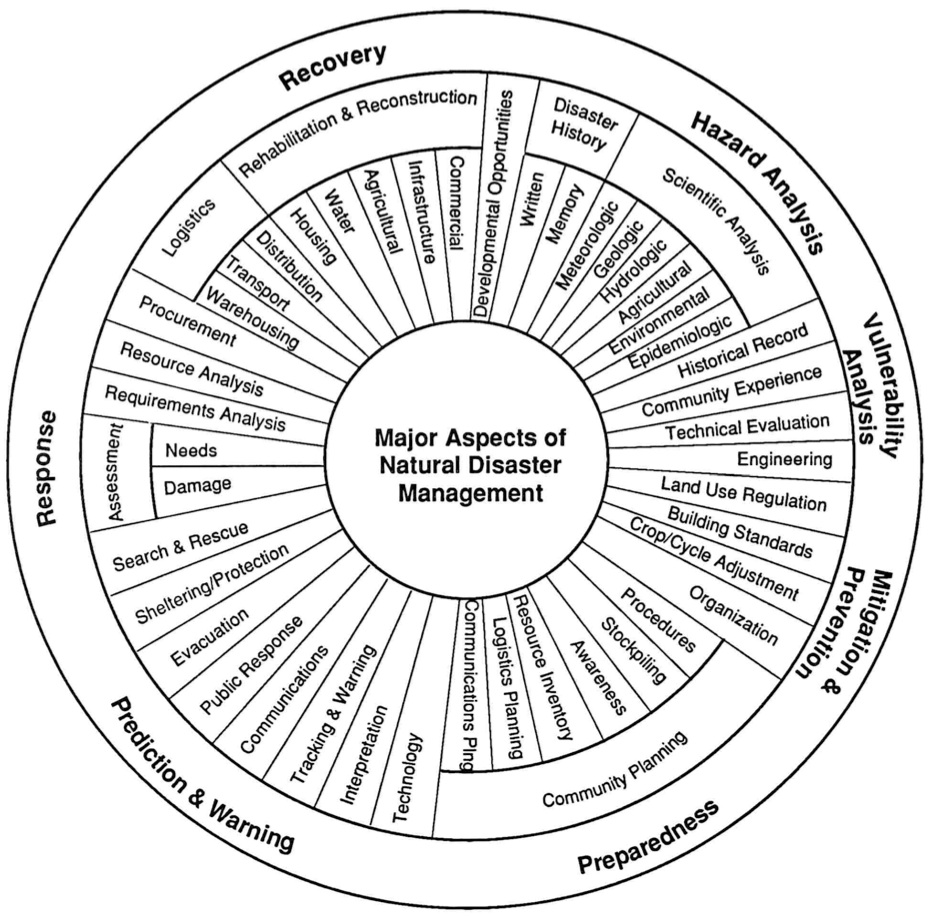
What's striking about this graphic is how little of it is taken up by what we might think of as classic disaster management - maybe a third of it - if you imagine it as a clock face, from about 8 'o' clock to midnight. Even then, the bit that generates most of the donations and media coverage lasts even less - by the time we get up to ten or eleven 'o' clock, when the slow, laborious process of recovery begins, the world's attention has usually moved on, barring major anniversaries and scandals. I think we're seeing this with Haiti right now. But fully half of the wheel is taken up with understanding and preparing for disasters before they happen. Another big slice represents the critical prediction and early warning analysis in which governments and local knowledge play an essential part.
Much of this work, all the way around the wheel, requires community participation - and quite right too. Requirements analysis and needs assessment need local knowledge and community input; reconstruction must be community-led and owned to be successful. Then follow the wheel round to between midnight and 1 'o' clock - there's a segment devoted to gathering disaster histories and experiences, both to learn and to help plan and prepare for future emergencies. Again, this is a key point of community action. Between 2 and 3 'o' clock, vulnerability analyses bring in community maps, workshops, focus group discussions, and other techniques to make sure that interventions and community support mechanisms reach the right people and places at the right moments. And last-mile disaster preparedness and early warning systems and mechanisms just won't work unless they are truly owned by the communities who have to enact them.
This will come as a surprise to none of you, given the focus of this blog, but: I think there's a significant opportunity here to use SMS to help communities to engage with these processes and get their views heard. Complaints and response systems, data-gathering, early warning and evacuation alerts all have and should be delivered using SMS, given its ubiquity in areas that are otherwise hard to reach. Two-way communication using an SMS hub running FrontlineSMS would enable you to send alerts, information about distributions, advice and even messages of support and solidarity; and more importantly, receive information about what's happening on the ground, invaluable local knowledge, and feedback on the success of programmes, and allow people to express what they are feeling. The Haiti experience has shown that this is possible in an emergency setting, and the important work of evaluating the success of those programmes is ongoing - the next step being to build on this learning to improve our understanding of best practice for SMS in emergencies. And as I write, agencies now experienced in using SMS in the fraught days after a disaster are thinking about how to maintain those links, and forge new ones, as they move into the 'recovery phase'. But many organisations are beginning to use SMS in the longer-term, more gradual process of helping people to mitigate and prepare for the risks they're exposed to - we know many are using FrontlineSMS.
We didn't get time to talk much about this on the day, but maybe we can carry on the conversation now. What do you think?
I really enjoyed the event and the thought-provoking discussions about digital activism. I'm very grateful to the DCI team for asking us to be part of the day, and to the lovely participants, who very obligingly joined in with a bit of what I like to call FrontlineSMS Pilates.


